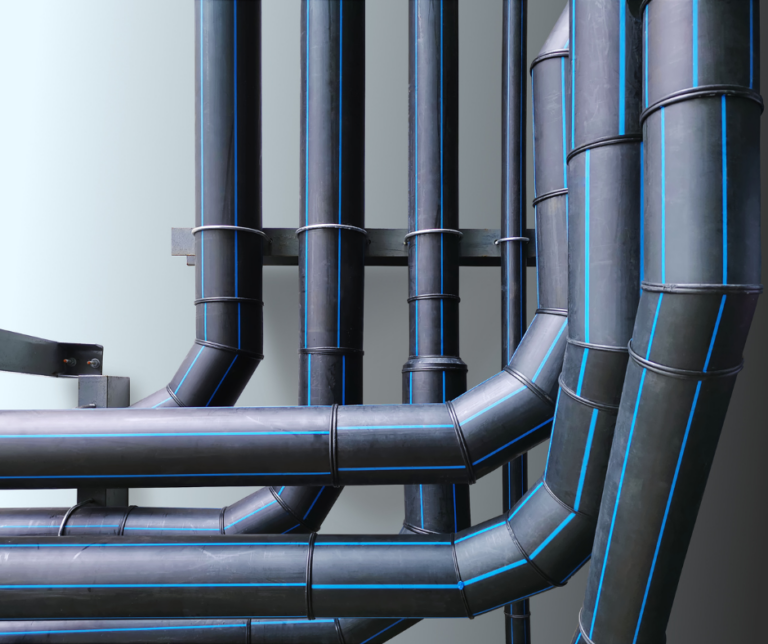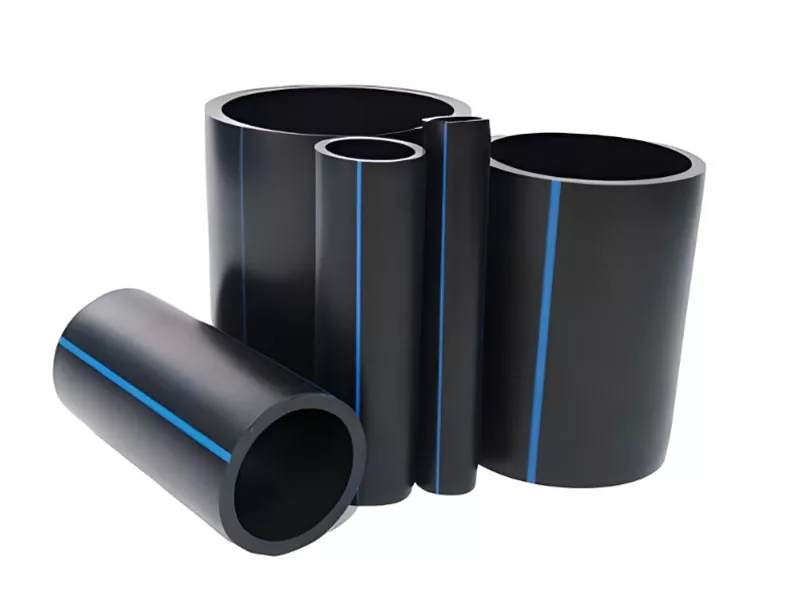Discover the Manufacturing Process Behind High-Quality HDPE Pipeline and Its Applications
The manufacturing process of high-grade HDPE pipelines is detailed and methodical. It starts with the option of raw products that boost performance. Following this, ethylene undertakes polymerization to create material, which is then formed with extrusion. Quality assurance is critical, making certain that the end product meets strict standards. However, the trip of HDPE pipes does not finish with manufacturing. Their applications throughout different industries reveal a wider importance worth checking out.
Comprehending HDPE: Properties and Advantages

High-density polyethylene (HDPE) is a flexible polycarbonate recognized for its longevity and resistance to different ecological factors. This product shows exceptional tensile strength, making it ideal for demanding applications. Its low-density framework adds to a lightweight product, assisting in ease of managing and installment. HDPE also showcases remarkable resistance to chemicals, which reduces deterioration when subjected to extreme substances.
The product's reduced moisture absorption better boosts its longevity, making it excellent for usage in pipes and tank. Additionally, HDPE is immune to ultraviolet (UV) radiation, making sure that items preserve their stability even when exposed to sunshine. Its adaptability permits for the production of elaborate shapes without compromising stamina. The eco-friendly nature of HDPE, often obtained from recycled products, contributes to its allure, advertising sustainable methods in production. Overall, these buildings and benefits make HDPE a preferred choice for numerous industrial and consumer applications.
Resources Selection for HDPE Manufacturing
The choice of basic materials for HDPE manufacturing is vital to validate the final item satisfies the desired requirements and top quality criteria. High-density polyethylene (HDPE) is primarily produced from polymerized ethylene, originated from nonrenewable fuel sources such as all-natural gas or petroleum. The top quality of these feedstocks significantly influences the mechanical and thermal properties of the last HDPE.
Ingredients also play a considerable function in improving HDPE's performance, including anti-oxidants, UV stabilizers, and colorants, which boost sturdiness and resistance to ecological variables. The choice procedure have to consider not only the chemical composition of the raw materials however additionally their processing features to ensure reliable production.
Additionally, the sourcing of raw materials should prioritize sustainability and compliance with ecological laws, as responsible methods are important in today's market. Inevitably, careful resources choice lays the structure for producing top quality HDPE pipes ideal for diverse applications.
The Extrusion Refine: Shaping HDPE Pipeline
The extrusion process plays a crucial function fit HDPE pipes, beginning with meticulous material prep work strategies that guarantee perfect circulation and consistency. Equally vital is the style of the die, which straight affects the last dimensions and surface area top quality of the pipe. Together, these aspects contribute significantly to the efficiency and high quality of HDPE pipe production.
Material Preparation Methods
Efficient manufacturing of HDPE pipes begins with precise material preparation techniques, particularly the extrusion procedure. During this stage, high-density polyethylene material is very first dried to get rid of wetness, guaranteeing perfect flow features. The resin is then fed right into the extruder, where it undergoes home heating and melting, transforming right into a viscous state. This home heating process is thoroughly regulated to keep the product's integrity and performance. The liquified HDPE is required through a die, shaping it right into a continuous pipeline form. Appropriate temperature management during extrusion is necessary, as it straight influences the material's buildings and the final product high quality. As soon as formed, the HDPE pipe is cooled and cut to defined sizes, ready for subsequent handling and applications.
Die Style Value
Accuracy in die design plays an essential function in the extrusion process of HDPE pipes. The die works as the final shaping device, straight influencing the pipeline's measurements, wall surface density, and surface coating. A well-designed die warranties uniform material flow, reducing issues such as abnormalities and weak points. The geometry of the die should be optimized to fit the specific properties of HDPE, including its viscosity and thermal actions during extrusion. Additionally, the cooling price of the material as it travels through the die can significantly affect the pipeline's architectural stability. As a result, investing in innovative die technology is important for suppliers intending to create high-quality HDPE pipelines that get more info fulfill sector criteria and client expectations.
Quality Control Procedures in HDPE Production
Different variables influence the quality of HDPE pipe manufacturing, effective high quality control procedures are critical to assure uniformity and reliability in the final item (Midland TX HDPE Pipe Fittings in Stock). Trick high quality control practices consist of extensive material inspection, validating that the raw polyethylene satisfies recognized criteria for pureness and thickness. Throughout the extrusion process, specifications such as temperature, pressure, and cooling time are closely kept an eye on to keep dimensional precision and structural honesty
Furthermore, post-production testing is necessary; suppliers usually perform hydrostatic examinations to assess the pipeline's stamina and resistance to stress. Visual evaluations for surface defects even more enhance quality control. Qualification from appropriate requirements companies, like ASTM or ISO, supplies an additional layer of trustworthiness. By executing these comprehensive quality control actions, manufacturers can decrease flaws, improve efficiency, and ensure that the HDPE pipelines meet the certain needs of different applications, ultimately resulting in client fulfillment and trust in the item.
Applications of HDPE Pipe Throughout Industries
HDPE pipes are utilized throughout various markets due to their longevity and convenience. In water distribution systems, they guarantee efficient shipment, while in wastewater administration, they offer dependable remedies for waste transportation. In addition, farming watering networks profit from HDPE's resistance to corrosion and flexibility, making it an excellent selection for contemporary farming techniques.

Water Distribution Equipments
A substantial variety of industries depend on high-density polyethylene (HDPE) pipelines for efficient water distribution systems. Recognized for their sturdiness and resistance to rust, HDPE pipes are widely made use of in municipal supply of water networks, farming watering, and industrial applications. Their light-weight nature facilitates easy handling and setup, minimizing labor expenses and time. Additionally, HDPE pipelines can accommodate different stress degrees, making them suitable for both low and high-pressure systems. hdpe pipe in stock Midland TX. The adaptability of the material enables seamless combination right into existing facilities, minimizing the need for extensive excavation. HDPE's resistance to chemical seeping assurances that the water delivered remains secure and tidy, making it a perfect option for preserving the top quality of safe and clean water across different industries.
Wastewater Administration Solutions
Effective water distribution systems likewise lead the way for ingenious wastewater monitoring options, where high-density polyethylene (HDPE) pipes play a substantial function. Distinguished for their sturdiness and resistance to deterioration, HDPE pipes are perfect for delivering wastewater in different settings. Their adaptability enables easy setup in complicated atmospheres, decreasing the demand for extensive excavation. Additionally, HDPE's smooth interior surface reduces friction, enhancing flow rates and effectiveness. These pipes are also immune to chemical leaching, guaranteeing that impurities do not jeopardize the surrounding atmosphere. Industries, communities, and therapy centers progressively count on HDPE pipelines for their dependability and long life, making them a favored option for modern-day wastewater monitoring systems. This adaptability highlights the critical value of HDPE pipelines across various applications.
Agricultural Watering Networks
Agricultural watering networks profit substantially from the use of high-density polyethylene (HDPE) pipes, which give efficient and dependable water shipment to plants. HDPE pipes are light-weight, making them simple to move and mount, while their versatility permits various arrangements in diverse surfaces. These pipes demonstrate outstanding resistance to deterioration, chemicals, and UV radiation, guaranteeing toughness in severe agricultural atmospheres. Furthermore, their smooth indoor surface area reduces rubbing loss, enhancing water circulation and minimizing energy expenses related to pumping. The longevity of HDPE pipes, often exceeding half a century, contributes to lower upkeep and replacement expenditures. Farmers progressively count on HDPE pipelines to improve irrigation effectiveness and promote lasting farming practices, eventually leading to enhanced crop yields and source preservation.

Future Fads in HDPE Pipe Technology
As the need for sustainable and effective framework expands, improvements in HDPE pipe technology are positioned to transform various industries. Arising fads include the integration of wise technologies, such as sensing units and IoT capacities, which facilitate real-time tracking of pipeline conditions, decreasing maintenance expenses and stopping leaks. Furthermore, the advancement of advanced manufacturing strategies, such as 3D printing, is making it possible for the manufacturing of facility, tailored pipe designs that deal with particular task demands.
The focus on recycling and round economy methods is driving the technology of HDPE pipelines made from recycled materials, boosting sustainability. Improved jointing approaches, such as electro-fusion and mechanical fittings, are additionally improving installment performance and reliability. Finally, the growing emphasis on environmental laws is pressing producers to take on greener manufacturing processes, guaranteeing that HDPE pipes not only fulfill market criteria however additionally cultivate a more lasting future for framework growth.
Frequently Asked Concerns
Just How Does HDPE Contrast to Other Plastic Products?
HDPE outperforms many various other plastic materials pertaining to longevity, chemical resistance, and flexibility. Its low density and high tensile toughness make it suitable for numerous applications, frequently surpassing alternatives in both performance and durability.
What Are the Environmental Effects of HDPE Manufacturing?
The ecological effects of HDPE manufacturing include greenhouse gas discharges, power intake, and prospective air pollution from making processes. Furthermore, inappropriate disposal can cause soil and water contamination, raising issues concerning lasting environmental impacts.
Can HDPE Pipeline Be Recycled?
Yes, HDPE pipelines can be recycled. Numerous facilities approve used HDPE for handling, changing it right into brand-new products. This reusing adds to sustainability initiatives, reducing plastic waste while preserving resources and energy in the production cycle.
What Is the Life-span of HDPE Pipes?

Exactly How Do Temperature Variants Impact HDPE Pipeline Performance?
Temperature variants greatly affect HDPE pipeline efficiency, impacting adaptability and strength. High temperature levels can lead to softening, while low temperatures may trigger brittleness, ultimately influencing the pipeline's toughness and viability for numerous applications in varied settings.